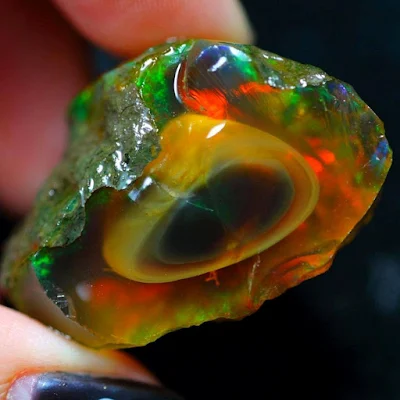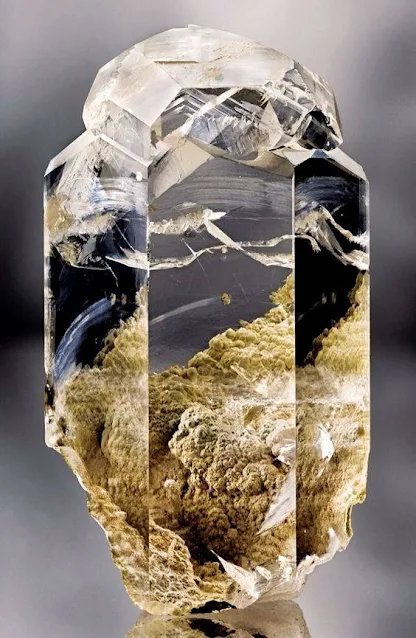Inclusions: Mineral Inclusions Types (Photos)
In the intricate world of geology, inclusions represent one of the most fascinating phenomena, offering invaluable insights into the Earth’s history, processes, and the myriad conditions under which minerals form. These small but significant features can be thought of as nature's time capsules, preserving moments from the planet’s geological past.
What are Inclusions
In geology, Inclusion is a piece of material trapped inside a rock or mineral during its formation. It can be a fragment of another rock, a mineral crystal, a fossil, or even a fluid bubble. Inclusions are important because they can provide clues about the conditions under which a rock formed and the age of the rock and its components.
Mineral inclusions are formed during the crystallization of minerals from a melt or solution. As a mineral grows, it may incorporate other minerals or solid materials that are present in the surrounding environment.
 |
| Types of Mineral Inclusions. Rainbow Lattice Sunstone from Mud Tank, Northern Territory, Australia. Photo © Kathy Kirk |
Types of Inclusions
The most common types of mineral inclusions are other minerals, but inclusions can also be composed of rocks, water, gas, or organic material.
Fluid Inclusions
Fluid inclusions are bubbles of liquid or gas that are trapped in a mineral during its formation. A Fluid can be "trapped" within the growing crystal at any time during its growth - or - at some later date it can infiltrate into the crystal. In some instances it can result from the chemical dissolution of portion(s) of the Host Crystal and/or an included mineral.
 |
| Fluorescent Petroleum bubbles inclusion Quartz |
The chemical composition and even the temperature of such an included liquid (and/or gas) can be studied - and - the information obtained can provide invaluable details relating to the growth, etc., of that crystal and/or the "environment" in which it grew.
Gaseous Inclusions
Gaseous inclusions, tiny pockets of trapped gas within a mineral, The composition and pressure of the trapped gases can reveal details about the temperature, pressure, and fluid composition during the host mineral's formation.
These occur in essentially the same way as for liquid inclusions - and - in some instances one can be derived from (and/or changed to) the other as a result of pressure and/or temperature change.
Types of Gaseous Inclusions:
Simple Gaseous Inclusions: These contain a single gas species, most commonly carbon dioxide (CO₂), nitrogen (N₂), or methane (CH₄).
Complex Gaseous Inclusions: These contain a mixture of gas species, offering more detailed information about the host mineral's formation conditions.
 |
| Golden Rutilate Inclusions in Quartz cluster from Brazil |
Solid Inclusions
Solid inclusions are other minerals or rock fragments that are trapped inside a mineral during its formation. Solid inclusions can be used to identify the different minerals and rocks that were present in the environment where the host mineral formed.
The Formation Solid Inclusions
The situation regarding an enclosed Solid Inclusion is, perhaps, even more complex :
- It could be a preexisting crystal (floating in a solution), which has been "entrapped" by the growing Host Crystal. This make a it an example of an Antegenic Inclusion.
- It may have been growing on the wall of a cavity and was, again, "entrapped" by the growing Host Crystal. Again, this is an example of an Antegenic Inclusion.
- It can occur as a result of the crystallisation of part of the liquid/gaseous chemical solutions "entrapped" within the Host Crystal.
- Depending on "when" this took place would determine whether it was an Antegenic Inclusion or Syngenetic Inclusion or Epigenetic Inclusion.
- It can occur as a result of crystallisation or recrystallisation of portion of the Host Crystal as a result of changes in temperature and/or pressure of the surrounding geological environment. This would make it an example of an Epigenetic Inclusion.
 |
| Natural Phantom Inclusion Ethiopian Welo Opal Credit: Castelltack |
Inclusions importance
Mineral inclusions, seemingly insignificant specks trapped within other minerals, hold a wealth of importance in various fields. They act like tiny time capsules, whispering stories of the Earth's history and revealing secrets about the formation and evolution of minerals themselves. Here's a deeper dive into their significance:
Geologists and Petrologists
Formation Clues: Inclusions provide clues about the temperature, pressure, and chemical conditions under which their host mineral formed. By analyzing the inclusions, geologists can reconstruct the history of geological processes and environments, like ancient volcanic eruptions or hydrothermal activity.
Mineral Relationships: Studying inclusions can reveal how different minerals interact and grow within each other, shedding light on mineral paragenesis (the order of mineral formation) and providing valuable insights into the evolution of rock formations.
Provenance Tracking: Inclusions with unique compositions or textures can be used to trace the origin of rocks and minerals, helping geologists understand their journey from formation to present location.
Mineralogists and Gemologists
Mineral Identification: Specific inclusions can be diagnostic of certain minerals, aiding in their identification and classification. This is particularly valuable for rare or complex minerals where other identification methods might be inconclusive.
Gemstone Enhancement: In some cases, inclusions can enhance the beauty and value of gemstones. Examples include rutile needles in sapphires creating the coveted "star effect" or gas bubbles in quartz known as "enhydros."
Rarity and Value: Certain types of inclusions, especially unusual or aesthetically pleasing ones, can significantly increase the value of gemstones. For instance, inclusions of other precious minerals like diamonds in garnets can fetch high prices.
Beyond Science
Artistic Inspiration: Inclusions have captivated artists for centuries, inspiring them with their intricate patterns, unexpected colors, and hidden worlds within. They serve as reminders of the beauty and complexity found in the smallest details of nature.
Historical Connection: Inclusions can offer glimpses into the past, reflecting the minerals and environments present during Earth's formation billions of years ago. They connect us to the vastness of geological time and the dynamic forces that shaped our planet.
Overall, mineral inclusions are not just tiny blemishes; they are windows into the Earth's history, keys to unlocking mineral mysteries, and sources of inspiration for both scientific and artistic endeavors. Their importance lies not only in their physical presence but also in the wealth of information and beauty they hold within.
Mineral Inclusions Photos
 |
| Calcite phantom from Verchniy Mine, Primorskiy Kray, Far-Eastern Region, Russia, Credit: Heritage Auctions |
 |
| Quartz with phantom (a secondary copper mineral) Looks like an erupting volcano. |
 |
| Contra Luz Natural Polished Ethiopian, Welo Crystal Opal Credit: OpalAuctions |
Understanding mineral inclusions is a fundamental aspect of mineralogy and gemology, contributing to our knowledge of Earth's geological history and providing practical applications in various industries.

%20(1).webp)






